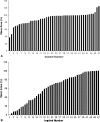Wear damage in mobile-bearing TKA is as severe as that in fixed-bearing TKA
- PMID: 21082364
- PMCID: PMC3008896
- DOI: 10.1007/s11999-010-1557-4
Wear damage in mobile-bearing TKA is as severe as that in fixed-bearing TKA
Abstract
Background: Mobile-bearing TKAs reportedly have no clinical superiority over fixed-bearing TKAs, but a potential benefit is improved polyethylene wear behavior.
Questions/purposes: We asked whether extent of damage and wear patterns would be less severe on retrieved mobile-bearing TKAs than on fixed-bearing TKAs and if correlations with patient demographics could explain differences in extent or locations of damage.
Methods: We performed damage grading and mapping of 48 mobile-bearing TKAs retrieved due to osteolysis/loosening, infection, stiffness, instability or malpositioning. Visual grading used stereomicroscopy to identify damage, and a grade was assigned based on extent and severity. Each damage mode was then mapped onto a photograph of the implant surface, and the area affected was calculated.
Results: Marked wear damage occurred on both surfaces, with burnishing, scratching, and pitting the dominant modes. Damage occurred over a large portion of both surfaces, exceeding the available articular borders in nearly 30% of implants. Wear of mobile-bearing surfaces included marked third-body debris. Damage on tibiofemoral and mobile-bearing surfaces was not correlated with patient BMI or component alignment. Damage on mobile-bearing surfaces was positively correlated with length of implantation and was greater in implants removed for osteolysis or instability than in those removed for stiffness or infection.
Conclusions: Each bearing surface in mobile-bearing implants was damaged to an extent similar to that in fixed-bearing implants, making the combined damage score higher than that for fixed-bearing implants. Mobile-bearing TKAs did not improve wear damage, providing another argument against the superiority of these implants over fixed-bearing implants.
Figures






Similar articles
-
Polyethylene Damage Increases With Varus Implant Alignment in Posterior-stabilized and Constrained Condylar Knee Arthroplasty.Clin Orthop Relat Res. 2017 Dec;475(12):2981-2991. doi: 10.1007/s11999-017-5477-4. Epub 2017 Aug 18. Clin Orthop Relat Res. 2017. PMID: 28822068 Free PMC article.
-
Implant design influences tibial post wear damage in posterior-stabilized knees.Clin Orthop Relat Res. 2011 Jan;469(1):160-7. doi: 10.1007/s11999-010-1515-1. Clin Orthop Relat Res. 2011. PMID: 20711697 Free PMC article.
-
Current modes of failure in TKA: infection, instability, and stiffness predominate.Clin Orthop Relat Res. 2014 Jul;472(7):2197-200. doi: 10.1007/s11999-014-3540-y. Epub 2014 Mar 11. Clin Orthop Relat Res. 2014. PMID: 24615421 Free PMC article.
-
Rotating-platform TKA no different from fixed-bearing TKA regarding survivorship or performance: a meta-analysis.Clin Orthop Relat Res. 2014 Jul;472(7):2185-93. doi: 10.1007/s11999-014-3539-4. Epub 2014 Mar 4. Clin Orthop Relat Res. 2014. PMID: 24590838 Free PMC article. Review.
-
The surgical options and clinical evidence for treatment of wear or corrosion occurring with THA or TKA.Clin Orthop Relat Res. 2014 Dec;472(12):3674-86. doi: 10.1007/s11999-014-3652-4. Clin Orthop Relat Res. 2014. PMID: 25024023 Free PMC article. Review.
Cited by
-
Bilateral massive osteolysis of uncertain origin after total knee arthroplasty: A case report and review of literature.Int J Surg Case Rep. 2021 Mar;80:105678. doi: 10.1016/j.ijscr.2021.105678. Epub 2021 Feb 26. Int J Surg Case Rep. 2021. PMID: 33676292 Free PMC article.
-
New total knee arthroplasty designs: do young patients notice?Clin Orthop Relat Res. 2015 Jan;473(1):101-8. doi: 10.1007/s11999-014-3713-8. Clin Orthop Relat Res. 2015. PMID: 24903823 Free PMC article.
-
[Effectiveness comparison of mobile-bearing and fixed-bearing prostheses in total knee arthroplasty for ten years follow-up].Zhongguo Xiu Fu Chong Jian Wai Ke Za Zhi. 2017 Mar 15;31(3):271-277. doi: 10.7507/1002-1892.201609030. Zhongguo Xiu Fu Chong Jian Wai Ke Za Zhi. 2017. PMID: 29806253 Free PMC article. Chinese.
-
Can microcomputed tomography measure retrieved polyethylene wear? Comparing fixed-bearing and rotating-platform knees.Clin Orthop Relat Res. 2013 Jan;471(1):86-93. doi: 10.1007/s11999-012-2513-2. Clin Orthop Relat Res. 2013. PMID: 22879092 Free PMC article.
-
Influence of third-body particles originating from bone void fillers on the wear of ultra-high-molecular-weight polyethylene.Proc Inst Mech Eng H. 2016 Aug;230(8):775-83. doi: 10.1177/0954411916651461. Epub 2016 Jun 16. Proc Inst Mech Eng H. 2016. PMID: 27312481 Free PMC article.
References
-
- Cottrell JM, Townsend E, Lipman J, Sculco TP, Wright TM. Bearing surface design changes affect contact patterns in total knee arthroplasty. Clin Orthop Relat Res. 2007;464:127–131. - PubMed
Publication types
MeSH terms
Substances
LinkOut - more resources
Full Text Sources
Medical

